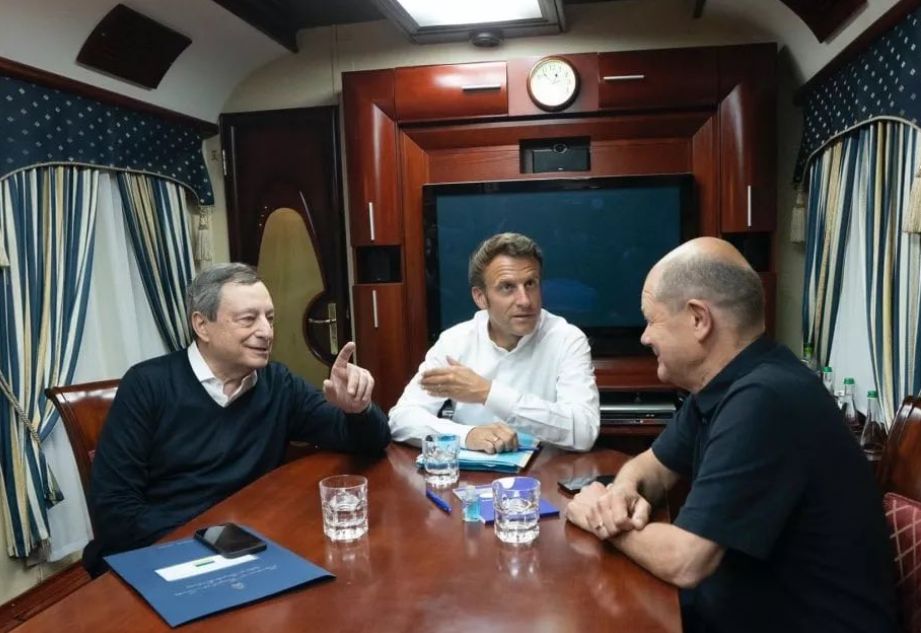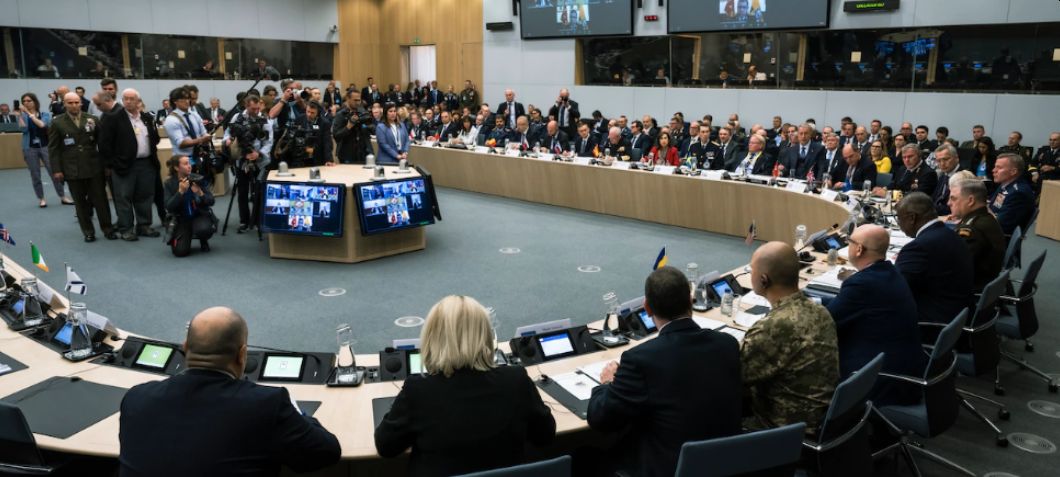By Eric Vandenbroeck and co-workers
Taking weeks to organize the leaders of Germany, France, and
Italy, below arrived in Kyiv today. Meanwhile, Ukrainian troops holed up
alongside civilians in a Sievierodonetsk chemical
plant ignored a Russian ultimatum to lay down their arms.

Why Ukraine
reaches a pivotal moment
Already a
week ago, several news sources asked if the Ukraine war is descending into
a ‘frozen conflict’?
While the war’s outcome hangs in the balance, as
pictured below on Wednesday, the United States and Western allies now
decided to deliver longer-range artillery and rocket launchers in limited
quantities, with ranges of no more than 80 kilometers, to help Ukraine close
the gap in long-range strike capabilities. Despite these new deliveries,
Russian President Vladimir Putin continues to bank on the assumption that Ukraine’s friends don’t have the
stamina to maintain pressure on Russia and support the Ukrainian people.

Last week we argued
that it is time for NATO leaders to accept reality
formally: Putin is a threat to the alliance and its members, and,
therefore, they should declare so in the strategic news concept. Indeed, not
declaring Russia a formal threat to NATO territory would compromise NATO’s
credibility and would give Putin a pass for the atrocities and violations he
has committed in Ukraine. Neither NATO nor the United States can afford to
allow that to happen.
Today United States has approved
a plan to send an additional $1 billion in military aid to Ukraine
following a meeting of NATO defense ministers in Brussels on Wednesday, but the
promised delivery falls well short of what Ukrainian officials say they will
need to roll back the Russian invasion.
Mykhailo Podolyak,
a top advisor to Ukrainian President Volodymyr Zelensky, outlined on Twitter
what Ukraine would need to win the war against Russia, which has been raging
since Moscow invaded in late February.
“Being straightforward—to end the war, we need heavy weapons parity:
1000 howitzers caliber 155 mm; 300 MLRS [Multiple Launch Rocket Systems]; 500
tanks; 2000 armored vehicles; 1000 drones,” he tweeted. So far, the United States
and its allies have pledged to send ten rocket systems to Ukraine—far short of
the 300 Podolyak says his country needs.
“What the Ukrainians need most is long-range artillery and rockets and
endless ammunition to counter Russia because that’s what Russia has so much of,
and that’s what’s causing all the damage now,” said retired Lt. Gen. Ben
Hodges, a former commander of the US Army in Europe.
Hodges said the United States should dramatically increase the number
of heavy weapons it sends Ukraine to help tip the scales of the war in Kyiv’s
favor, particularly since Russia has a dramatic advantage in terms of the
number of troops and artillery systems it can put into the field—even if those
troops are poorly trained and equipped.
“Unless we can help Ukraine destroy or at least disrupt all of this
artillery and rockets pounding away at Ukrainian positions, then it becomes a
matter of math,” he said.
Ukrainian officials are also frustrated that the delivery timetables
for heavy weapons systems aren’t moving as quickly as they need. The United
States and its allies face steep logistical hurdles in rapidly delivering such
equipment—and it will take weeks or months to train Ukrainian forces on such
systems.
For weeks capturing
Severodonetsk has been a top military goal for Russia, which now controls
most of the city.
“We’re here, focused, and we’re about to meet President Zelenskyy now
to visit a war site where massacres have been committed, and then to lead the
conversations that are scheduled with President Zelenskyy,” Macron said in
comments to reporters at the train station in Kyiv.
The visit is “a message of European unity toward Ukrainians, and of
support, [a message] about the present and the future because we know the weeks
to come are going to be very difficult,” the French president added.
The European leaders will visit Irpin, the
suburb northwest of Kyiv where Russian invaders destroyed buildings and
allegedly tortured and killed civilians during weeks of occupation before
Ukrainian forces pushed them out.
A French diplomatic official told reporters that once Russia’s war is
over, “a dialogue” between Moscow and Kyiv “will be needed to find out how we
build a sustainable peace,” with security guarantees for Ukraine, and the
nature of the relationship between Ukraine and NATO.
The official added: “Zelenskyy must define what would be a military
victory for him … We are in favor of a complete victory with the
re-establishment of [Ukrainian] territorial integrity over all the territories
that have been conquered by the Russians including Crimea.”
The joint visit from the leaders of the three largest EU economies
carries important symbolic weight, especially ahead of a meeting of EU leaders
next week, when they are set to decide whether to grant Ukraine candidate
status to join the bloc. What Macron, Scholz, and Draghi will say on the matter
is still unclear.
Romanian President Klaus Iohannis joined the three leaders in Kyiv,
taking another route on Thursday morning.
Putin does not seem to be
in a hurry
For his part, Putin does not seem to be in a hurry. This week the
Russian president compared himself to Peter the
Great, saying that the 18th-century czar “waged the Great Northern War
[against Sweden] for 21 years” to win back territory that was rightfully
Russia’s.
Putin has also been leveraging the war’s devastating impact on the
global economy to his advantage, blaming the
growing global food crisis on Western sanctions against Russia. The
message may be resonating: After a meeting with Putin in Sochi this week,
Senegalese President Macky Sall,
chair of the African Union, called on “partners” to lift sanctions, saying
that Putin had expressed willingness to facilitate grain exports through the
Black Sea — even as his military has bombed and blockaded Black Sea ports.

Three possible outcome
scenarios
Russia could continue to
make incremental gains in two key eastern provinces. Or the battle
lines could harden into a stalemate that drags on for months or years, leading
to tremendous casualties and a slow-rolling crisis that will continue to drain
the global economy.
Then there is what officials consider the least likely possibility:
Russia could redefine its war aims, announce that it has achieved victory, and
attempt to engineer a close to the fighting. For now, sources say that scenario
appears to be little more than wishful thinking.
Suppose Russia can consolidate some of its
gains in the east. In that case, US officials increasingly fear
that Russian President Vladimir Putin may eventually be able to use that
territory as a staging ground to push further into Ukraine.
Western officials broadly believe Russia is in a more favorable
position in the east, based solely on mass. Still, “Russian progress is not a
foregone conclusion,” said one senior Biden administration official.
As the front lines of the conflict have settled into a war of attrition
built around back-and-forth artillery fire, both sides have suffered tremendous
casualties and now face potential manpower shortfalls. Russia has also suffered
losses of as much as a third of its ground force, and US intelligence officials
have said publicly that Russia will struggle to make any severe gains without a
total mobilization, a politically dangerous move that Putin has so far been
unwilling to make.
For now, the fighting is centered on two sister cities on opposite
sides of the Seversky Donets River, Sievierodonetsk, and Lysychansk.
Ukrainian fighters are almost entirely encircled at
Sievierodonetsk.
For updates click hompage here